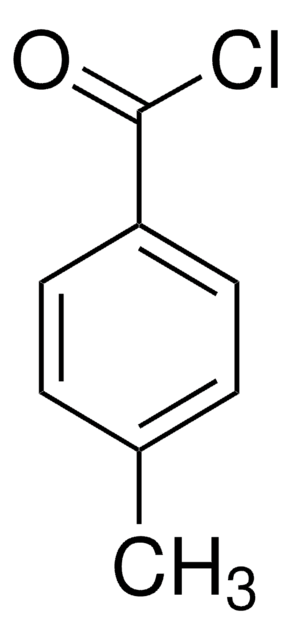T36803
p-Toluic acid
98%
Sinónimos:
4-Methylbenzoic acid
About This Item
Productos recomendados
Análisis
98%
bp
274-275 °C (lit.)
mp
177-180 °C (lit.)
cadena SMILES
Cc1ccc(cc1)C(O)=O
InChI
1S/C8H8O2/c1-6-2-4-7(5-3-6)8(9)10/h2-5H,1H3,(H,9,10)
Clave InChI
LPNBBFKOUUSUDB-UHFFFAOYSA-N
¿Está buscando productos similares? Visita Guía de comparación de productos
Categorías relacionadas
Aplicación
- One-Pot Synthesis of 1,3-Cyclohexadienes by Birch Reduction in the Presence of Carbonyl Compounds.: This paper presents a novel synthetic approach involving p-Toluic acid, useful for chemists and researchers in synthetic chemistry aiming to develop more efficient synthesis routes (Linker et al., 2024).
Palabra de señalización
Warning
Frases de peligro
Consejos de prudencia
Clasificaciones de peligro
Skin Sens. 1
Código de clase de almacenamiento
11 - Combustible Solids
Clase de riesgo para el agua (WGK)
WGK 1
Punto de inflamabilidad (°F)
357.8 °F
Punto de inflamabilidad (°C)
181 °C
Equipo de protección personal
Eyeshields, Gloves, type N95 (US)
Certificados de análisis (COA)
Busque Certificados de análisis (COA) introduciendo el número de lote del producto. Los números de lote se encuentran en la etiqueta del producto después de las palabras «Lot» o «Batch»
¿Ya tiene este producto?
Encuentre la documentación para los productos que ha comprado recientemente en la Biblioteca de documentos.
Los clientes también vieron
Nuestro equipo de científicos tiene experiencia en todas las áreas de investigación: Ciencias de la vida, Ciencia de los materiales, Síntesis química, Cromatografía, Analítica y muchas otras.
Póngase en contacto con el Servicio técnico














